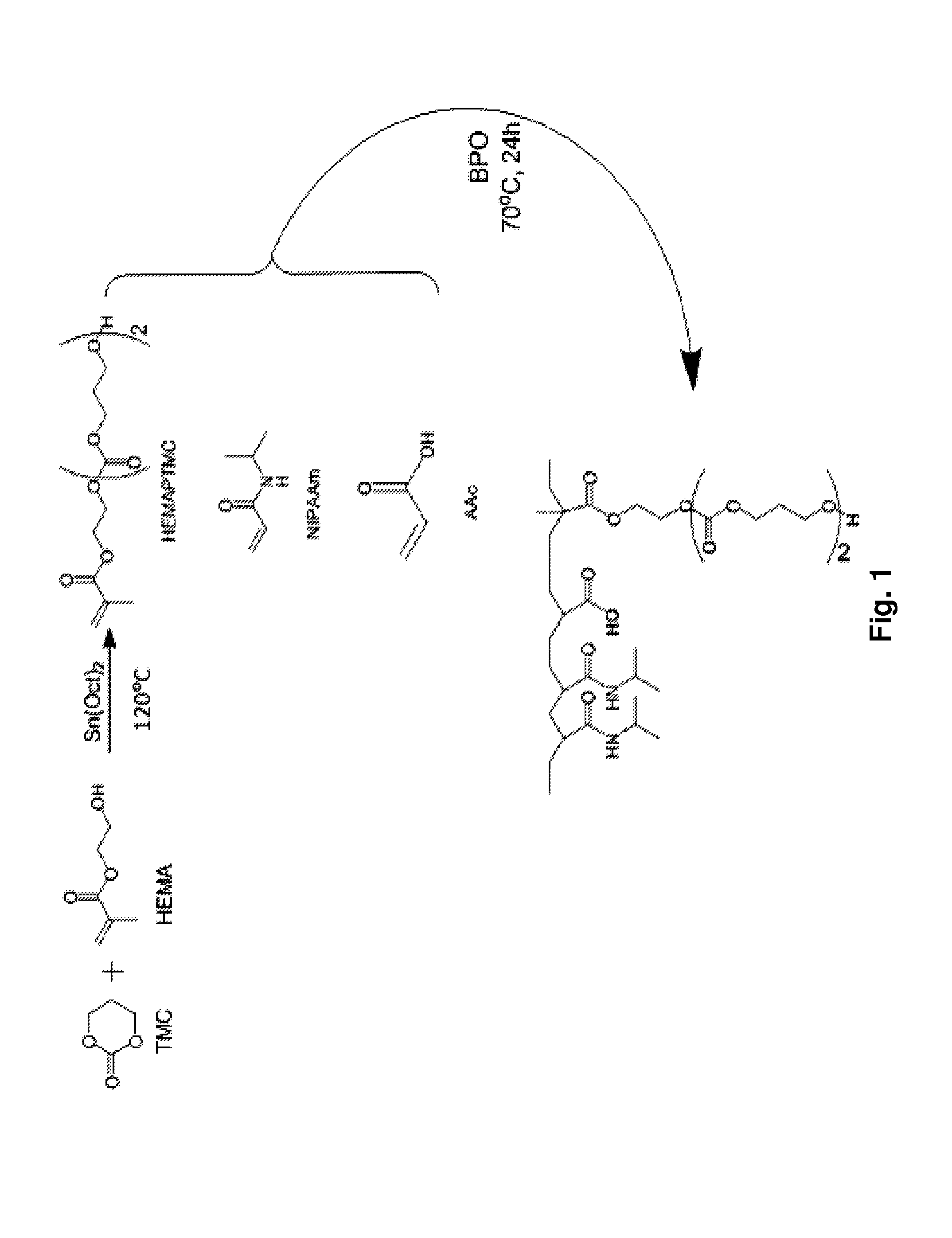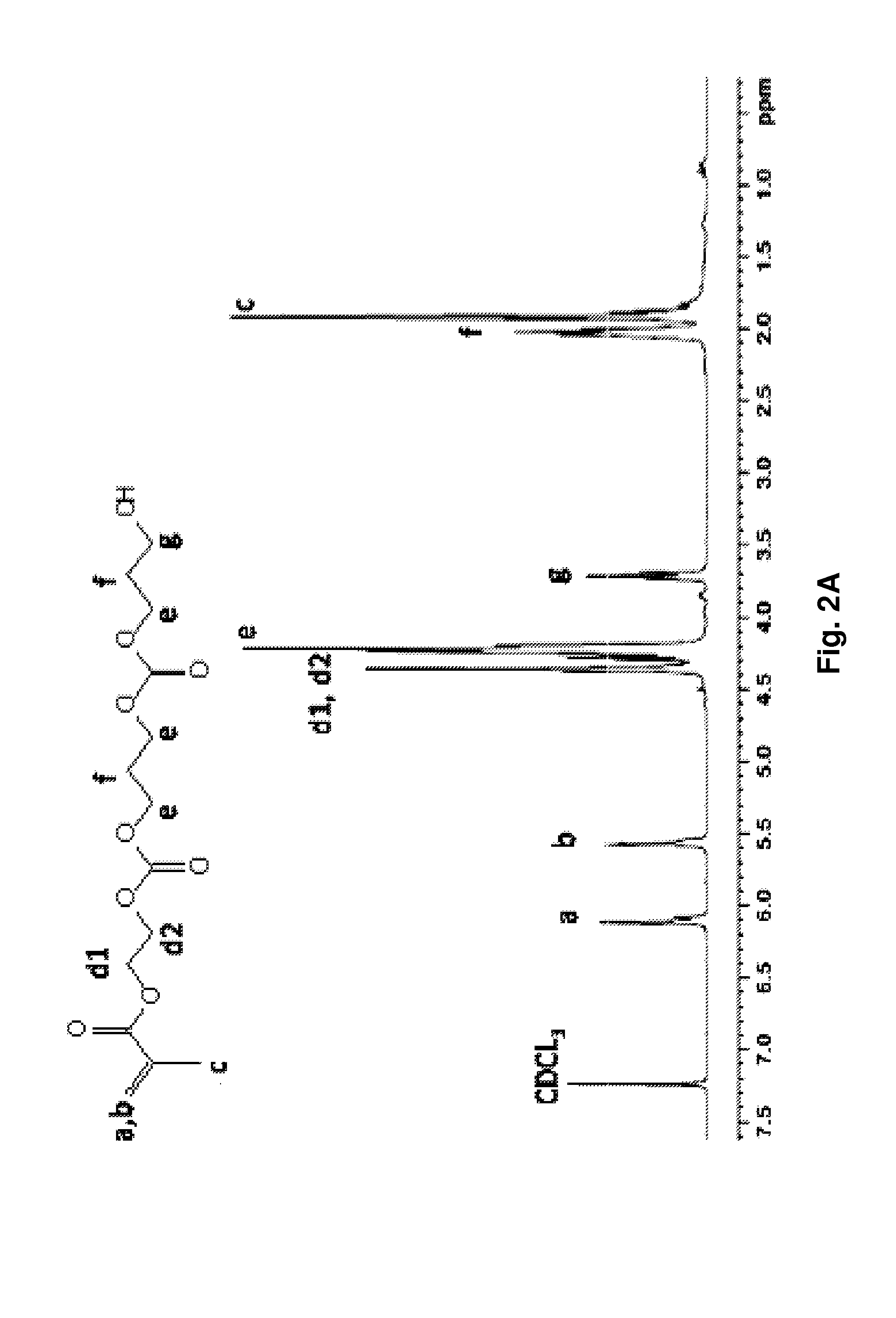Thermoresponsive, biodegradable, elastomeric material and uses therefor
a technology of elastomeric materials and biodegradable materials, applied in the field of thermoresponsive, biodegradable elastomeric materials, to achieve the effect of high flexibility
- Summary
- Abstract
- Description
- Claims
- Application Information
AI Technical Summary
Benefits of technology
Problems solved by technology
Method used
Image
Examples
example 1
A Thermally Responsive Injectable Hydrogel Incorporating Hydroxyethyl Methacrylate-Polylactide for Hydrolytic Lability
[0081]Novel thermally responsive injectable and bioabsorbable hydrogel by copolymerization of N-isopropylacrylamide (NIPAAm), acrylic acid (AAc), and biodegradable monomer hydroxyethyl methacrylate-poly(trimethylene carbonate) (HEMAPTMC) is synthesized and evaluated. We sought to investigate and tune the molecular design by altering the relative amount of AAc so that a thermoresponsive hydrogel would be achieved with an LCST below body temperature prior to hydrolysis of the poly(trimethylene carbonate) (PTMC) branches, but with an LCST that rose above body temperature with PTMC cleavage. The HEMAPTMC component was selected and synthesized for use since the carbonate bond in PTMC should have a hydrolysis rate that would allow retention of the gel over the several week period that we hypothesize would be necessary for the cardiac application in vivo. After characterizi...
example 2
A Thermally Responsive Injectable Hydrogel Incorporating Methacrylate-Polylactide for Hydrolytic Lability
[0121]To overcome the limitations associated with previous NIPAAm copolymers utilizing HEMA-based co-monomers for hydrolytic lability, our objective was to synthesize a non-HEMA-based biodegradable monomer, methacrylate-polylactide (MAPLA), which would present highly hydrophilic carboxylate groups upon hydrolysis of the PLA segments and does not contain the acrylic acid residues. The MAPLA monomer was then used as the basis for the development of bioabsorbable and thermally responsive NIPAAm-based copolymer hydrogels. Copolymers were synthesized using monomer NIPAAm, HEMA and MAPLA at three different monomer ratios. The resulting hydrogels were characterized in terms of their composition and thermal, mechanical, hydrolytic and cytocompatability properties.
[0122]Methacrylate-polylactide (MAPLA), with an average 2.8 lactic acid units, was synthesized and copolymerized with n-isopro...
example 3
Synthesis of NIPAAm-Based Random and Block Copolymers as Biodegradable Thermally Responsive Hydrogels (HEMAPTMC and HEMAPLA)
[0153]An ABA type block copolymer where A=poly(NIPAAm-co-HEMA-co-MAPLA) (80 / 10 / 10) and B=polyethylene glycol (PEG) was synthesized by atom transfer radical polymerization (ATRP). Molecular weight of the A and B blocks can be controlled to obtain hydrogels with different water content and mechanical properties. These hydrogels have potentials to be applied for injection therapy of ischemic cardiomyopathy to alter adverse remodelling and preserve cardiac function post-infarction.
[0154]Specifically, ABA type block copolymers were synthesized by ATRP. First, α-bromisobutyric acid PEG ester (BBPEG) was synthesized by reacting one of three PEGs (1, 6 or 20 kD) and α-bromoisobutyryl bromide. NIPAAm, HEMA and MAPLA were copolymerized for 24 h in methanol containing BBPEG, CuCl and the ligand 1,4,8,11-tetramethyl-1,4,8,11-tetraazacyclotetradecane with a molar ratio of 1...
PUM
| Property | Measurement | Unit |
|---|---|---|
| Temperature | aaaaa | aaaaa |
| Time | aaaaa | aaaaa |
| Temperature | aaaaa | aaaaa |
Abstract
Description
Claims
Application Information
 Login to View More
Login to View More - R&D
- Intellectual Property
- Life Sciences
- Materials
- Tech Scout
- Unparalleled Data Quality
- Higher Quality Content
- 60% Fewer Hallucinations
Browse by: Latest US Patents, China's latest patents, Technical Efficacy Thesaurus, Application Domain, Technology Topic, Popular Technical Reports.
© 2025 PatSnap. All rights reserved.Legal|Privacy policy|Modern Slavery Act Transparency Statement|Sitemap|About US| Contact US: help@patsnap.com



